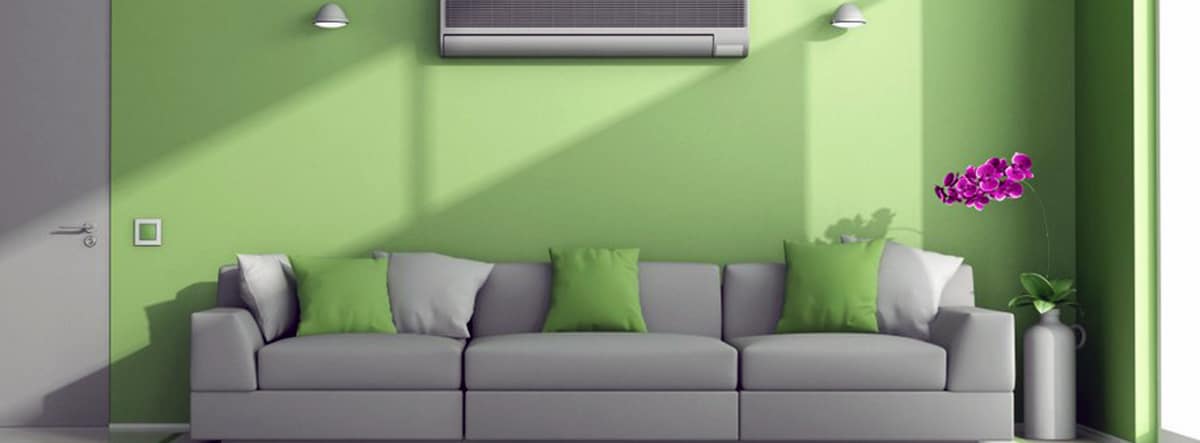
Mini Split and HVAC Sizing Calculator
What Size Mini Split Should You Buy
When upgrading your home's HVAC equipment or purchasing a new system, the most crucial step is getting the right size for the space.
To help you, we've created this quick and easy sizing calculator. After you've entered your room information, you'll be armed with the power to build the perfect mini split system for optimal comfort and efficiency.
How to Use the Mini Split Sizing Calculator
Our free mini split calculator tool will ask you for the information needed to produce a general sizing estimate. It provides recommended BTUs for one room at a time, so if you are considering a multi-zone application, you can fill out the calculator for each room and add your load requirements together.
Step 1: Basic Info
In step one, the calculator will ask you to fill out basic info about your room, including its size, age, and type (bedroom, kitchen, office, etc.). This information will set the general parameters of your application. For example, knowing your building age helps the calculator understand the quality of insulation inside your home.
When you complete “Step 1,” click “Calculate Load Estimates,” and you’ll have the option to skip straight to preliminary results or to continue filling out information in “Step 2.” We recommend providing more information to allow the calculator to produce a more accurate recommendation.
Step 2: Room Info
In “Step 2,” you’ll fill out more details about the room for which you’re sizing the mini split. First, set your desired indoor cooling and heating temperatures. Next, provide details about the number of windows and how exposed your walls, ceiling, and floor are. All this information is critical for the calculator to determine your room’s heat gain/loss and how many BTUs you need your mini split to provide.
Step 3: Construction
In the final step, you will expand on the information in “Step 2” regarding wall, window, ceiling, and floor details. You’ll provide information about your wall materials, floor construction, and ceiling shape. The purpose, again, is to help the calculator determine your heat gains/losses.
Step 4: Results
Once you’ve finished filling out the calculator steps (or if you skipped ahead in Step 1), you’ll be taken to your results page, which will display total load calculations and allow you to download, print, or email your results.
You’ll see both a cooling load estimate and a heating load estimate. If you click on the estimates or on “Shop Mini Splits” you’ll be navigated to a page listing out systems that fit those needs. Remember, these are good faith estimates that can help get you started in picking the right mini split, but they’re not a replacement for professional sizing.
Why is Mini Split Sizing Important?
The size of a mini split refers to its capacity or ability to condition a given area usually measured in BTUs.
Getting the wrong capacity can be a costly mistake. Even though mini splits use efficient inverter technology, you'll still need to make sure it will be able to handle the load requirements based on factors like: size and construction of your room, outdoor temperature range, etc.
If the system is too small, you'll find yourself wasting energy while your unit runs continuously, all the while failing to keep you comfortable in extreme conditions. This lack of performance will leave you on the hunt, yet again, for a better solution.
If the system is too large, you'll spend more on equipment and throw any energy savings out the window. Oversized equipment will also fail prematurely due to short cycling (turning on and off frequently).
Share My Personal Information\":{\"href\":\"https:\\\/\\\/ferguson.bigidprivacy.cloud\\\/consumer\\\/#\\\/dMf02ovZbN\\\/Form-NHWperWAaFNVIQK\",\"title\":\"Do Not Sell or Share My Personal Information\"}},\"About Us\":{\"Our Story\":{\"href\":\"https:\\\/\\\/www.powerequipmentdirect.com\\\/stories\\\/1982-How-We-Make-Buying-Technical-Products-Simple.html\",\"title\":\"eComfort's Story\"},\"Careers\":{\"href\":\"https:\\\/\\\/www.powerequipmentdirect.com\\\/stories\\\/1924-Job-Openings.html\",\"title\":\"Careers @ Power Equipment Direct\"},\"Newsroom\":{\"href\":\"newsreleases.php\",\"title\":\"eComfort News Center\"}},\"Contact Us\":{\"phone\":\"866-554-4328\",\"hours\":[\"M-F: 8-5 CST\",\"Sat: Closed\",\"Sun: Closed\"]}}","storeLinkJSON":"{\"AC Wholesalers\":{\"href\":\"https:\\\/\\\/www.acwholesalers.com\",\"title\":\"AC Wholesalers\"},\"Air Compressors Direct\":{\"href\":\"https:\\\/\\\/www.aircompressorsdirect.com\",\"title\":\"Air Compressors Direct\"},\"Chain Saws Direct\":{\"href\":\"https:\\\/\\\/www.chainsawsdirect.com\",\"title\":\"Chain Saws Direct\"},\"Chippers Direct\":{\"href\":\"https:\\\/\\\/www.chippersdirect.com\",\"title\":\"Chippers Direct\"},\"eComfort\":{\"href\":\"https:\\\/\\\/www.ecomfort.com\",\"title\":\"eComfort\"},\"Electric Generators Direct\":{\"href\":\"https:\\\/\\\/www.electricgeneratorsdirect.com\",\"title\":\"Electric Generators Direct\"},\"Leaf Blowers Direct\":{\"href\":\"https:\\\/\\\/www.leafblowersdirect.com\",\"title\":\"Leaf Blowers Direct\"},\"Log Splitters Direct\":{\"href\":\"https:\\\/\\\/www.logsplittersdirect.com\",\"title\":\"Log Splitters Direct\"},\"Mowers Direct\":{\"href\":\"https:\\\/\\\/www.mowersdirect.com\",\"title\":\"Mowers Direct\"},\"Power Equipment Direct\":{\"href\":\"https:\\\/\\\/www.powerequipmentdirect.com\",\"title\":\"Power Equipment Direct\"},\"Pressure Washers Direct\":{\"href\":\"https:\\\/\\\/www.pressurewashersdirect.com\",\"title\":\"Pressure Washers Direct\"},\"Snow Blowers Direct\":{\"href\":\"https:\\\/\\\/www.snowblowersdirect.com\",\"title\":\"Snow Blowers Direct\"},\"String Trimmers Direct\":{\"href\":\"https:\\\/\\\/www.stringtrimmersdirect.com\",\"title\":\"String Trimmers Direct\"},\"Sump Pumps Direct\":{\"href\":\"https:\\\/\\\/www.sumppumpsdirect.com\",\"title\":\"Sump Pumps Direct\"},\"Tillers Direct\":{\"href\":\"https:\\\/\\\/www.tillersdirect.com\",\"title\":\"Tillers Direct\"},\"Water Pumps Direct\":{\"href\":\"https:\\\/\\\/www.waterpumpsdirect.com\",\"title\":\"Water Pumps Direct\"}}","socialLinkJSON":"{\"Facebook\":{\"href\":\"https:\\\/\\\/www.facebook.com\\\/eComfortusa\",\"icon\":\"icon-facebook\",\"title\":\"Facebook\"},\"Twitter\":{\"href\":\"http:\\\/\\\/www.twitter.com\\\/eComfortUSA\",\"icon\":\"icon-twitter\",\"title\":\"Twitter\"},\"Pinterest\":{\"href\":\"http:\\\/\\\/pinterest.com\\\/ecomfort\\\/\",\"icon\":\"icon-pinterest\",\"title\":\"Pinterest\"},\"YouTube\":{\"href\":\"https:\\\/\\\/www.youtube.com\\\/c\\\/Ecomfortholdings\",\"icon\":\"icon-youtube\",\"title\":\"YouTube\"},\"Instagram\":{\"href\":\"https:\\\/\\\/www.instagram.com\\\/ecomfortusa\\\/\",\"icon\":\"icon-instagram\",\"title\":\"Instagram\"},\"LinkedIn\":{\"href\":\"https:\\\/\\\/www.linkedin.com\\\/company\\\/power-equipment-direct\\\/\",\"icon\":\"icon-linkedin\",\"title\":\"LinkedIn\"}}","miscLinkJSON":"{\"Terms of Use\":{\"href\":\"terms-of-use.php\",\"title\":\"Terms of Use\"},\"Privacy Policy & Security\":{\"href\":\"privacy.php\",\"title\":\"Privacy Policy and Security\"},\"Cookie Policy\":{\"href\":\"privacy.php#cookiePolicy\",\"title\":\"Cookie Policy\"},\"CA Privacy Rights\":{\"href\":\"privacy.php#californiaPrivacyRights\",\"title\":\"CA Privacy Rights\"},\"copyright\":\"© 2024 Power Equipment Direct. All Rights Reserved\"}","checkoutMiscLinkJSON":"{\"Privacy Policy & Security\":{\"href\":\"privacy.php\",\"title\":\"Privacy Policy and Security\"},\"Cookie Policy\":{\"href\":\"privacy.php#cookiePolicy\",\"title\":\"Cookie Policy\"},\"Terms of Use\":{\"href\":\"terms-of-use.php\",\"title\":\"Terms of Use\"},\"copyright\":\"© 2024 Power Equipment Direct. All Rights Reserved\"}","expertJSON":{"imageURL":"https:\/\/www.powerequipmentdirect.com\/images\/experts\/expert-main-15-18.png","href":"\/ecomfort-product-expert.php","title":"Contact Ken @ eComfort","expertName":"Ken","expertTitle":"eComfort Product Expert"},"bbbJSON":{"imageURL":"https:\/\/www.powerequipmentdirect.com\/images\/badge-bbb.png","imageAlt":"Better Business Bureau","href":"http:\/\/www.bbb.org\/chicago\/business-reviews\/industrial-equipment-and-supplies\/power-equipment-direct-in-bolingbrook-il-57001088","title":"eComfort - A+ Rating - Better Business Bureau"},"zipCode":null,"phoneNumber":"866-554-4328","loginToken":"page cache precludes the use of csrf tokens","iterable":"e4b27e68b9c84fbb940829a0a9ee29d7","newNav":false}


